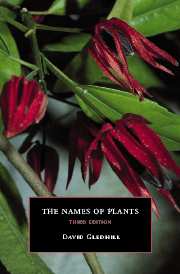Book contents
- Frontmatter
- Contents
- Preface to the first edition
- Preface to the third edition
- The nature of the problem
- The size of the problem
- Towards a solution to the problem
- The rules of botanical nomenclature
- The International Code of Nomenclature for Cultivated Plants
- Botanical terminology
- The glossary
- Addendum to glossary
- Bibliography
The rules of botanical nomenclature
Published online by Cambridge University Press: 06 July 2010
- Frontmatter
- Contents
- Preface to the first edition
- Preface to the third edition
- The nature of the problem
- The size of the problem
- Towards a solution to the problem
- The rules of botanical nomenclature
- The International Code of Nomenclature for Cultivated Plants
- Botanical terminology
- The glossary
- Addendum to glossary
- Bibliography
Summary
The rules which now govern the naming and the names of plants really had their beginnings in the views of A. P. de Candolle as he expressed them in his Théorie Elémentaire de la Botanique (1813). There, he advised that plants should have names in Latin (or Latin form but not compounded from different languages), formed according to the rules of Latin grammar and subject to the right of priority for the name given by the discoverer or the first describer. This advice was found inadequate and, in 1862, the International Botanical Congress in London adopted control over agreements on nomenclature. Alphonse de Candolle (1806–1893), who was A. P. de Candolle's son, drew up four simple ‘Lois’, or laws, which were aimed at resolving what threatened to become a chaotic state of plant nomenclature. The Paris International Botanical Congress of 1867 adopted the Lois, which were:
One plant species shall have no more than one name.
No two plant species shall share the same name.
If a plant has two names, the name which is valid shall be that which was the earliest one to be published after 1753.
The author's name shall be cited, after the name of the plant, in order to establish the sense in which the name is used and its priority over other names.
It can be seen from the above Lois that, until the nineteenth century, botanists frequently gave names to plants with little regard either to the previous use of the same name or to names that had already been applied to the same plant.
- Type
- Chapter
- Information
- The Names of Plants , pp. 25 - 45Publisher: Cambridge University PressPrint publication year: 2002



